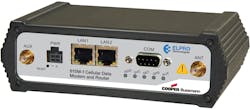During interviews for my upcoming article on wireless sensor networks (scheduled for November 2012), I had an interesting side conversation with Steve Toteda, vice president and general manager of the wireless business unit at Cooper Industries and chairman of the Wireless Industrial Networking Alliance (WINA). He was describing work Cooper Industries is doing in Mexico to monitor and maintain oil pipelines.
“In these applications there is a hierarchy of networking tools with sensor networks being used with instrumentation on the pipeline to capture data and transmit it back to the control system via high-speed backhaul,” Toteda said. “This combination of technologies—wired, wireless and cellular—has really brought wireless to the forefront [in such applications] because you’re mixing multiple technologies to monitor pipelines in 20-30 kilometer segments. As you do this with several segments, you’re effectively able to monitor hundreds of kilometers of pipelines.”
As we talked further about the blurring lines between wireless and cellular in automation applications, he mentioned that Cooper Industries is just now launching a product that can carry I/O traffic on a cellular network by creating a secure tunnel between the I/O network and control system and then leveraging a public carrier’s network.
“There’s no reason you can’t use a public carrier’s network—using encryption—to carry the important info you have across the globe,” Toteda says.
The new product Toteda refers to is Cooper Bussman’s ELPRO 615M-1 multi-service provider cellular broadband router. This router reportedly delivers wireless data connectivity for up to two LAN connections and one serial port through public cellular networks at 3G network speeds.
Technologies used to leverage multi-carrier protocols to deliver this combination of wireless and cellular control system connectivity include: UMTS technology, which uses high-speed HSPA to provide data access at speeds up to 14.4Mbps with backward compatibility to GSM’s EDGE and GPRS. CDMA technology uses high-speed EV-DO Rev A to provide data access at speeds up to 3.1Mbps with backward compatibility to EV-DO Rev 0 and CDMA 1 x RTT.
With its ability to provide real-time redundancy between carriers in case of a network failure, the router is said to deliver reliable connectivity for programmable logic controllers, remote terminal units, Ethernet Web cameras or any other Ethernet connectivity device.
The ELPRO 615M-1 features an integrated DHCP server, port forwarding and port mapping capabilities. Other features include:
• Receive antenna diversity
• Client and router configuration
• TCP/IP packet assembler/dis-assembler for serial devices
• Internal PPTP VPN server and client
• IPsec, GRE tunneling, PPTP, VPN, RADIUS/802.1x
• MAC and IP address filtering
• ARP/GARP filtering – whitelist/blacklist
• Dual 10/100baseT IEEE 802.3 Ethernet
• RS-232 serial port
• Analog I/O and digital I/O
• Over-the-air network diagnostics and configuration
• Auto-redial for always-on connection
• USB configuration and firmware programming
“The blending of wireless tools and techniques is what’s coming to forefront of industry,” said Toteda. “More and more engineers are recognizing there is a wide variety of wireless tools for use in automation.”
Leaders relevant to this article:


